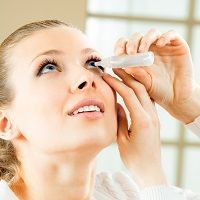Article
Study Identifies Potential Type 2 Diabetes plus Dry Eye Biomarkers
Author(s):
New research shows patients with both conditions have greater levels of particular cytokines and metabolic proteins.

Investigators may have uncovered factors that would influence a different pathogenesis of dry eye among patients with type 2 diabetes, versus the ophthalmologic condition in those without.
In new data published online during the Association for the Research of Vision and Ophthalmology (ARVO) 2020 Virtual Sessions this year, a team of Scotland clinicians reported worsened metrics of quality of life and differing biomarkers among patients with both dry eye and type 2 diabetes.
The findings, authored by Mungunshur Byambajav, MD, of the Department of Vision Sciences at Glasgow Caledonian University, School of Health and Life Sciences, also helped distinguish levels of tear fluid inflammatory cytokines and metabolic protein levels among the differing patient populations of those with dry eye.
Byambajav and colleagues sought to enhance understanding of dry eye in type 2 diabetes by assessing these levels, as well as ocular surface health parameters.
“In addition, the study aimed to detect how (dry eye) affects the Quality of Life of subjects in these study groups,” they wrote.
A group of 21 patients were divided into 4 groups: those with both type 2 diabetes and dry eye (n= 6), only type 2 diabetes (n= 4), only dry eye (n= 4), and healthy controls (n= 7).
Patients completed the ocular surface disease index (OSDI) and Dry Eye-Related Quality of Life (DEQS) questionnaires. Additionally, they underwent the Schimer I test, the Non-Invasive Tear Break Up Time (NITBUT), and the Corneal Fluorescein Staining (CFS) test.
Using Multiplex magnetic bead analysis, investigators assessed the following inflammatory cytokines: endothelial growth factor (EGF), Fractalkine, IFN-γ, interleukin 10 (IL-10), IL-17A, IL-1RA, IL-1β, IL-2, IL-4, IL-6, IL-8, IP-10, MCP-1, TNF-α, vascular EGF (VEGF). They additionally assessed metabolic proteins including c-peptide, ghrelin, GIP, GLP-1, glucagon, insulin, and leptin.
Among patients with type 2 diabetes and dry eye, DEQS score was significantly higher than that of diabetes-only (P = .012), dry eye-only (P = .046), and healthy controls (P = .003), indicating significantly worse quality of life. The same patient group reported the highest levels of IL-6, IP-10, and c-peptide.
Patients with only dry eye reported the highest levels of IL-8, VEGF, and glucagon. In the type 2 diabetes and dry eye group, investigators observed a negative correlation between tear fluid fractalkine, IL-1β, and insulin levels with the NITBUT value.
They also observed a negative correlation between EGF, IL-1RA, and leptin levels with the Schirmer score in patients with both conditions.
“In the (diabetes-only) group, leptin positively correlated with Schirmer and negatively correlated with OSDI,” investigators wrote. “In the (dry eye-only) group, Leptin and EGF levels positively correlated with NITBUT. In addition, there was a positive correlation between IL-6 levels and CFS for the (dry eye-only) group.”
Byambajav and colleagues concluded patients with type 2 diabetes and dry eye fare significantly worse in quality of life measures than those with just 1 of the diseases or neither. They also found that IL-6, IP-10, and c-peptide levels could potentially serve as diagnostic biomarkers for diabetes-related dry eye.
“This suggests that there may be a different pathogenesis underpinning dry eye in T2D versus dry eye in non-diabetic subjects,” they concluded. “Further investigations are needed in larger patient cohorts.”
The study, “Tear Fluid Inflammatory Cytokines and Metabolic Proteins Levels in Type 2 Diabetes-Related Dry Eye,” was published online in Investigative Ophthalmology & Visual Science.





